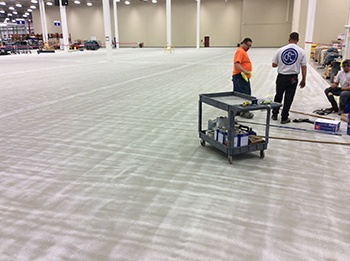
Nothing brings out the aesthetic qualities of concrete quite like a shiny urethane floor coating. Urethane can completely rejuvenate the appearance of an aging concrete floor, while protecting it from impacts, oils, dirt, and abrasion. And not only is urethane strong—under the right conditions, it can last for a decade or more.
Before a beautiful new urethane floor coating can be applied, the old concrete surface must be prepped. Otherwise, the coating will not bind to the floor evenly, and bubbles, cracks, or other problems could result. At times the coating will fail completely and begin to peel off within months or even weeks.
This is why proper concrete surface preparation before application is priority number one.
Here are the vital steps to prepare your old concrete floor so that the new urethane floor coating will look great and function as well as possible:
Test for Moisture
Moisture is the enemy of floor coatings—or any materials that rest upon concrete, for that matter. Water under the surface in the form of vapor can eventually change the chemical composition of the concrete and coatings to create problems.
While old concrete floors have completed their curing process and typically have very little moisture to release, some sites have latent moisture that comes from underground sources. This vapor can pass through the concrete and cause problems with coating applications.
That’s why it’s important to have a professional test the moisture content of the floors. Once you know exactly what you’re dealing with, you can determine whether you’ll need a moisture vapor barrier or another preventative measure.
Clean the Surface
Once underlying moisture issues are handled, the floor needs to be cleaned of oils and dirt. Degreaser products or a 50% caustic soda solution may be used to scrub the surface and completely remove any latent oils or other contaminants.
The surface should then be flushed or neutralized to remove any residual contaminates. Steam cleaning can also be an option for removing heavy deposits.
Repair the Surface
Any cracks, spalling, finishing defects and other concrete damage should be repaired, and cut joints may need to be filled. Urethane floor coatings require a clean, even surface before application.
Final Surface Preparation
In order for the surface to be completely ready for an industrial urethane floor system, it must have the proper profile for the coating and/or primer to adhere to. This step ensures a strong bond and even layering.
Options for creating texture include:
- Mechanical Abrasion: Dimatic grinders or shot blaster are the most standard and commonly used by professionals
- Acid etching: One of the most common forms of concrete surface preparation by DIYs, but it is not recommended.
Using the proper methods will create a clean, uniform, textured concrete surface that leads to an even coat of industrial urethane systems.
While these steps do take time and energy, they’re the only way to ensure that your urethane floor coating bonds properly, protecting your floor and staying beautiful for years to come.
If you’re in the Southeastern U.S. and would like to hire a professional crew with the equipment to get the job done quickly and accurately, talk to a flooring expert at CPC Floor Coatings.

